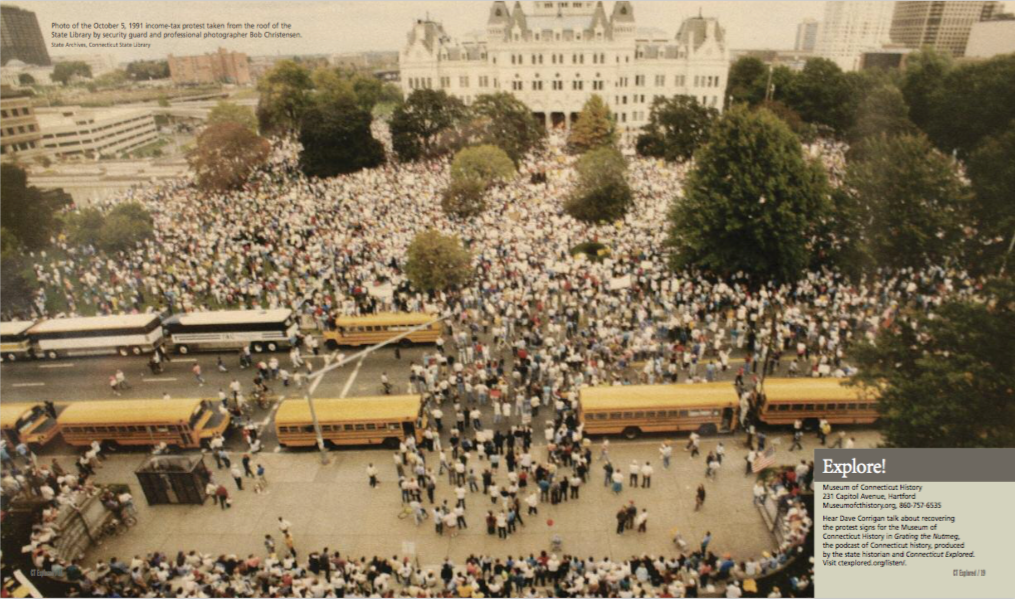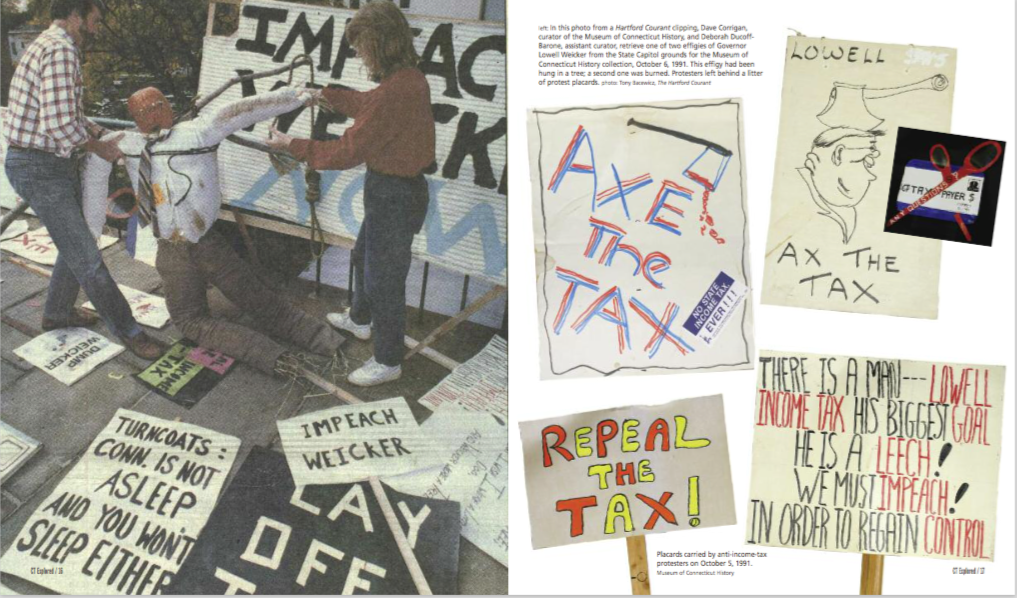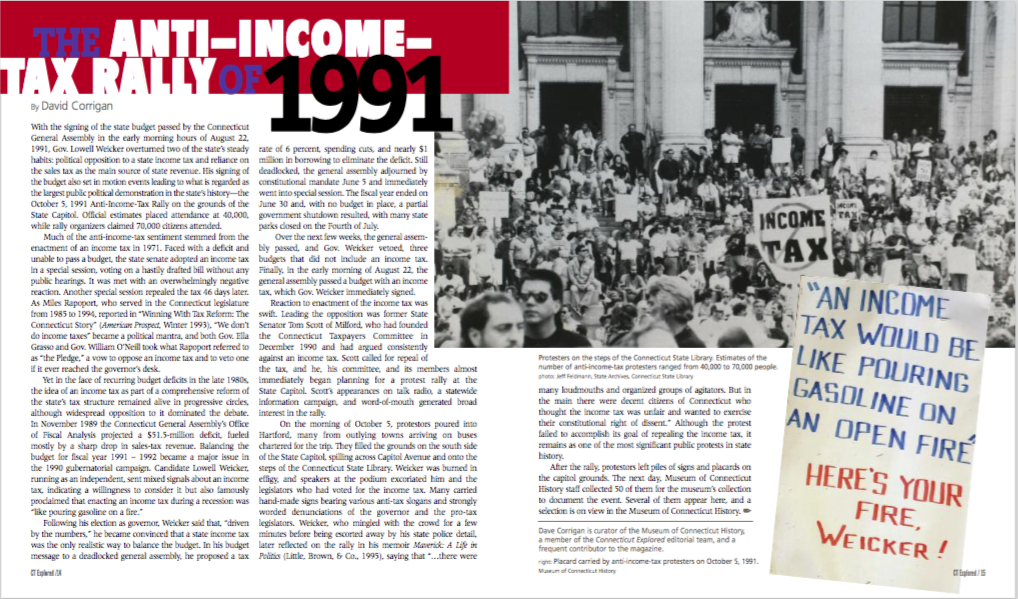(c) Connecticut Explored, Spring 2016
With the signing of the state budget passed by the Connecticut General Assembly in the early morning hours of August 22, 1991, Gov. Lowell Weicker overturned two of the state’s steady habits—political opposition to a state income tax and reliance on the sales tax as the main source of state revenue. His signing of the budget also set in motion events leading to what is regarded as the largest public political demonstration in the state’s history—the October 5th 1991 Anti-Income Tax Rally on the grounds of the State Capitol. Official estimates placed attendance at 40,000, while rally organizers claimed 70,000 citizens attended.
Much of the anti-income tax sentiment stemmed from the enactment of an income tax in 1971. Faced with a deficit and unable to pass a budget, the State Senate adopted an income tax in a special session, voting on a hastily drafted bill without any public hearings. It was met with an overwhelmingly negative reaction. Another special session repealed the tax 46 days later. As Miles Rapoport, who served in the Connecticut legislature from 1985 to 1994, reported in “Winning With Tax Reform: The Connecticut Story” (American Prospect, Winter 1993), “We don’t do income taxes” became a political mantra and both Gov. Ella Grasso and Gov. William O’Neill, took what Rapoport referred to as “the Pledge,” a vow to oppose an income tax and to veto one if it ever reached the governor’s desk.
Yet, in the face of recurring budget deficits in the late 1980s, the idea of an income tax as part of a comprehensive reform of the state’s tax structure remained alive in progressive circles, although widespread opposition to it dominated the debate. In November 1989 the Connecticut General Assembly’s Office of Fiscal Analysis projected a $51.5-million deficit, fueled mostly by a sharp drop in sales-tax revenue. Balancing the budget for fiscal year 1991 – 1992 became a major issue in the 1990 gubernatorial campaign. Candidate Lowell Weicker, running as an independent, sent mixed signals on an income tax, indicating a willingness to consider it, but also famously proclaimed that enacting an income tax during a recession was “like pouring gasoline on a fire.”
Following his election as governor, Weicker said that, “driven by the numbers,” he became convinced that a state income tax was the only realistic way to balance the budget. In his budget message to a deadlocked general assembly, he proposed a tax rate of 6 percent, spending cuts, and nearly $1 million in borrowing to eliminate the deficit. Still deadlocked, the general assembly adjourned by constitutional mandate June 5 and immediately went into special session. The fiscal year ended on June 30 and, with no budget in place, a partial government shutdown resulted, with many state parks closed on the Fourth of July.
Over the next few weeks, the general assembly passed, and Gov. Weicker vetoed, three budgets that did not include an income tax. Finally, in the early morning of August 22, the general assembly passed a budget with an income tax, which Gov. Weicker immediately signed.
Reaction to enactment of the income tax was swift. Leading the opposition was former State Senator Tom Scott of Milford, who had founded the Connecticut Taxpayers Committee in December 1990 and had argued consistently against an income tax. Scott called for repeal of the tax, and he, his committee, and its members almost immediately began planning for a protest rally at the State Capitol. Scott’s appearances on talk radio, a statewide information campaign, and word-of-mouth generated broad interest in the rally.
On the morning of October 5, protestors poured into Hartford, many from outlying towns on buses chartered for the trip. They filled the grounds on the south side of the State Capitol, spilling across Capitol Avenue and onto the steps of the Connecticut State Library. Weicker was burned in effigy, and speakers at the podium excoriated him and the legislators who had voted for the income tax. Many carried hand-made signs bearing various anti-tax slogans and strongly worded denunciations of the governor and the pro-tax legislators. Weicker, who mingled with the crowd for a few minutes before being escorted away by his state police detail, later reflected on the rally in his memoir Maverick: A Life in Politics (Little, Brown, & Co., 1995), saying that “…there were many loudmouths and organized groups of agitators. But in the main there were decent citizens of Connecticut who thought the income tax was unfair and wanted to exercise their constitutional right of dissent.” Although the protest failed to accomplish its goal of repealing the income tax, it remains as one of the most significant public protests in state history.
After the rally, protestors left piles of signs and placards on the capitol grounds. The next day, Museum of Connecticut History staff collected 50 of them for the museum’s collection to document the event. Several of them appear here, and a selection is on view in the Museum of Connecticut History.
Dave Corrigan is curator of the Museum of Connecticut History, a member of the Connecticut Explored editorial team, and a frequent contributor to the magazine.
Explore!
VISIT: Museum of Connecticut History, 231 Capitol Avenue, Hartford. Museumofcthistory.org, 860-757-6535
LISTEN: Hear Dave Corrigan talk about recovering the protest signs for the Museum of Connecticut History in Grating the Nutmeg, the podcast of Connecticut history, produced by the state historian and Connecticut Explored. Visit ctexplored.org/listen/ or subscribe (free) on iTunes.

